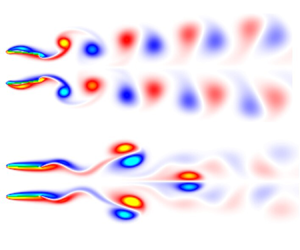Article contents
Intermittent swimming of two self-propelled flexible fins with laterally constrained heaving motions in a side-by-side configuration
Published online by Cambridge University Press: 11 April 2023
Abstract

Inspired by the intermittent locomotion of fish schools, numerical simulations are performed with two self-propelled flexible fins in a side-by-side configuration with anti-phase oscillation actuated by laterally constrained heaving motions. For an intermittent swimming gait, one type of the half-tail-beating mode (HT mode) and two types of multiple-tail-beating modes coasting at the smallest (MTS mode) and largest (MTL mode) lateral gap distances are applied. Similar to the continuous-tail-beating mode (CT mode), equilibrium lateral gap distances between two fins with HT and MTL modes exist, whereas two fins with MTS mode do not maintain a lateral equilibrium state. Although the cycle-averaged lateral force acting on two fins with CT and MTL modes is mostly determined by an outward deflected jet and enhanced positive pressure between two fins, an added-mass lateral force related to an asymmetric flapping kinematics by passive flexibility also plays an important role in MTL mode to achieve a stable state with a lateral gap distance smaller than that in CT mode. When the cruising speed or the cycle-averaged input power is identical in a stable state, the cost of transport (COT) for two fins with MTL mode is smaller than that with CT mode due to not only a benefit from the intermittent swimming gait but also an enhanced schooling benefit with a small equilibrium lateral gap distance. The COT for two fins with CT mode is reduced further when the bending rigidity increases, whereas it is opposite with MTL mode.
JFM classification
Information
- Type
- JFM Papers
- Information
- Copyright
- © The Author(s), 2023. Published by Cambridge University Press
References
- 8
- Cited by


